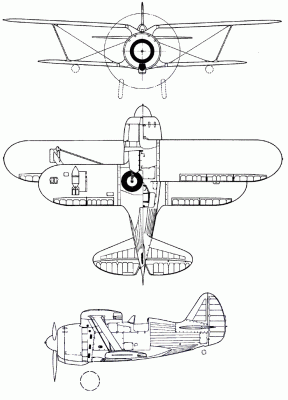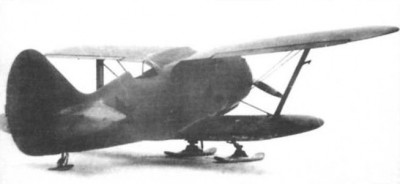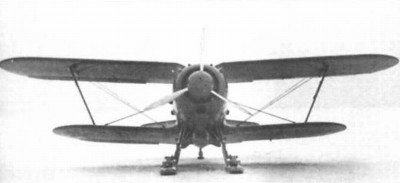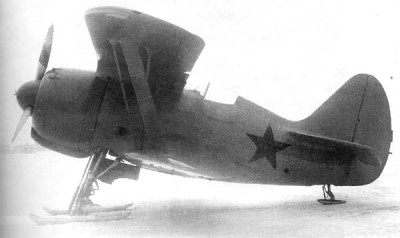| Název: Name: | Polikarpov I-190 | Polikarpov I-190 |
| Originální název: Original Name: | Поликарпов И-190 | |
| Kategorie: Category: | stíhací letoun | fighter aeroplane |
| Výrobce: Producer: | DD.MM.1939-DD.MM.1939 Moskevský letecký závod č. 1 Aviachimu, Moskva | |
| Období výroby: Production Period: | DD.MM.1939-25.05.1939 | |
| Vyrobeno kusů: Number of Produced: | 1 | |
| První vzlet: Maiden Flight: | 30.12.1939 | |
| Osádka: Crew: | 1 | |
| Základní charakteristika: Basic Characteristics: | ||
| Vzlet a přistání: Take-off and Landing: | CTOL - konvenční vzlet a přistání | CTOL - conventional take-off and landing |
| Uspořádání křídla: Arrangement of Wing: | dvouplošník | biplane |
| Uspořádání letounu: Aircraft Concept: | klasické | conventional |
| Podvozek: Undercarriage: | zatahovací | retractable |
| Přistávací zařízení: Landing Gear: | kola/lyže | wheels/ski |
| Technické údaje: Technical Data: | ||
| Hmotnost prázdného letounu: Empty Weight: | 1761 kg | 3882 lb |
| Vzletová hmotnost: Take-off Weight: | 2112 kg | 4656 lb |
| Maximální vzletová hmotnost: Maximum Take-off Weight: | 2321 kg | 5117 lb |
| Rozpětí: Wingspan: | 10,000 m | 32ft 9,75in |
| Délka: Length: | 6,700 m | 21ft 11,75in |
| Výška: Height: | 3,550 m | 11ft 7,75in |
| Plocha křídla: Wing Area: | 24,83 m2 | 267.27 ft2 |
| Plošné zatížení: Wing Loading: | 85,058 kg/m2 | 17.42 lb/ft2 |
| Pohon: Propulsion: | ||
| Kategorie: Category: | pístový | piston |
| Počet motorů: Number of Engines: | 1 | |
| Typ: Type: | Tumanskij M-88 vzduchem chlazený dvouhvězdicový čtrnáctiválec o vzletovém výkonu 735,5 kW (1 000 k) a nominální výkon 809 kW (1 100 k) v h= 4 800 m. Vrtule trojlistá a nastavitelným úhlem náběhu těchto typů: AV-2L-1 o průměru 2 750 mm, později AV-2L-2 o průměru 2 650 mm AV-2L-3 o průměru 2 650 mm | Tumansky M-88 fourteen-cylinder air-cooled two-row radial engine rated at 986 hp for take-off and nominal power 1,085 hp at 15,748 ft, driving a three-blade variable pitch propeller of Type: AV-2L-1 of 9ft diameter AV-2L-2 of 8ft 8.1/3in AV-2L-3 of 8ft 8.1/3in. |
| Objem palivových nádrží: Fuel Tank Capacity: | 316 l | 69.5 UK gallons (83.5 US gallons) |
| Výkony: Performance: | ||
| Maximální rychlost: Maximum Speed: | 490 km/h v 7050 m | 304.5 mph in 23130 ft |
| Cestovní rychlost: Cruise Speed: | 400 km/h v 4580 m | 248.5 mph in 15026 ft |
| Rychlost stoupání: Climb Rate: | 14,116 m/s | 2778.7 ft/min |
| Čas výstupu na výšku: Time to Climb to: | 5,9 min do 5000 m | 5,9 min to 16404 ft |
| Operační dostup: Service Ceiling: | 12400 m | 40682 ft |
| Dolet: Range: | 450 km | 279.6 mi |
| Maximální dolet: Maximum Range: | 720 km | 447.4 mi |
| Výzbroj: Armament: | 4x pevný kulomet ŠKAS ráže 7,62 mm, s celkovou zásobou 2 600 nábojů. Pumový náklad: do 200 kg(2x FAB-100) | Four fixed forward-firing 0.3 inch ShKAS machine-guns, 2,600 rounds of ammunition total. Bomb load: Up to 441 lb bombs (two FAB-100). |
| Uživatelské státy: User States: | | |
| Poznámka: Note: | viz historie letounu | The I-190 was an experimental fighter prototype produced by the Soviet Polikarpov Design Bureau, which sought in the late 1930’s to enhance the performance of its I-153 biplane fighter. The I-153 was developed from the I-15, which had has already fought with in the Spanish Civil War. The I-153 itself saw combat in a Soviet-Japanese border clash at Halhin Gol in Mongolia in 1939. The I-190’s proponents at Polikarpov, encouraged by the brass in the Soviet VVS who believed biplanes would retain a role in the world’s air forces, sought to extend the I-153’s viability with improved performance in the face of a wave of new monoplane fighters introduced by the other major powers. Both the I-153 and the I-190 had a distinct look due to the inverted gull dihedral of the upper wing, a design aspect that was retained despite its unpopularity among pilots since it reduced their visibility. The I-190 had an enlarged double-row Tumansky M-88 radial engine of 1,100 horsepower, requiring a larger, longer, re-designed cowl. Despite these changes, the I-190 never went into production, as it never achieved the desired improved performance. This was due in part to the increased weight resulting from the longer fuselage, larger engine, and the replacement of the original fabric ailerons with plywood, all of which adversely affected the I-190’s power-to-weight ratio and overall performance. The Polikarpov I-190 was the last of Nikolai Polikarpov's biplane fighter designs to take to the air, but only the first prototype was completed and the project was abandoned early in 1941. |
| Zdroje: Sources: | Michail Maslov, И-180 / И-185, Russian, Moscow, Tekhnika-molodezhi, Vostochnyi gorizont, 2003. http://aviair.ru/i153/id/247 www.aviarmor.net http://avia-museum.narod.ru/russia/pol_i-190.html http://www.airwar.ru/enc/fww2/i190.html http://www.redov.ru/voennaja_istorija/.../p39.php school415.narod.ru www.historyofwar.org http://www.ctrl-c.liu.se/misc/ram/i-190.html | |
| Period | - |
| Producer | - |
| Type | - |
| Camouflage | - |
| Country | - |
| Pilot | - |
| Production No. | - |
| Serial No. / Evidence No. | - |
| Tactical Marking / Imatriculation | - |
| Name | - |
| Unit | - |
| Base | - |
| Date (DD.MM.RRRR) | DD.MM.RRRR |
| Author | - |
| Print size / 300 DPI | - |
| Published with authors permit | - |
| Author Website | - |
| Period | - |
| Producer | - |
| Type | - |
| Camouflage | - |
| Country | - |
| Pilot | - |
| Production No. | - |
| Serial No. / Evidence No. | - |
| Tactical Marking / Imatriculation | - |
| Name | - |
| Unit | - |
| Base | - |
| Date (DD.MM.RRRR) | DD.MM.RRRR |
| Author | - |
| Print size / 300 DPI | - |
| Published with authors permit | - |
| Author Website | - |
| Period | - |
| Producer | - |
| Type | - |
| Camouflage | - |
| Country | - |
| Pilot | - |
| Production No. | - |
| Serial No. / Evidence No. | - |
| Tactical Marking / Imatriculation | - |
| Name | - |
| Unit | - |
| Base | - |
| Date (DD.MM.RRRR) | DD.MM.RRRR |
| Author | - |
| Print size / 300 DPI | - |
| Published with authors permit | - |
| Author Website | - |
| Period | - |
| Producer | - |
| Type | - |
| Camouflage | - |
| Country | - |
| Pilot | - |
| Production No. | - |
| Serial No. / Evidence No. | - |
| Tactical Marking / Imatriculation | - |
| Name | - |
| Unit | - |
| Base | - |
| Date (DD.MM.RRRR) | DD.MM.RRRR |
| Author | - |
| Print size / 300 DPI | - |
| Published with authors permit | - |
| Author Website | - |



